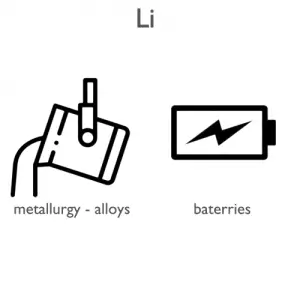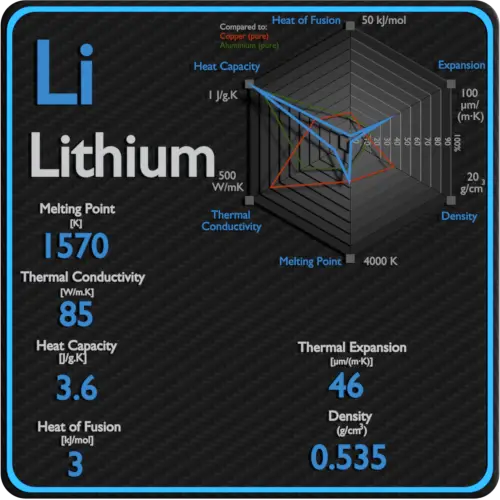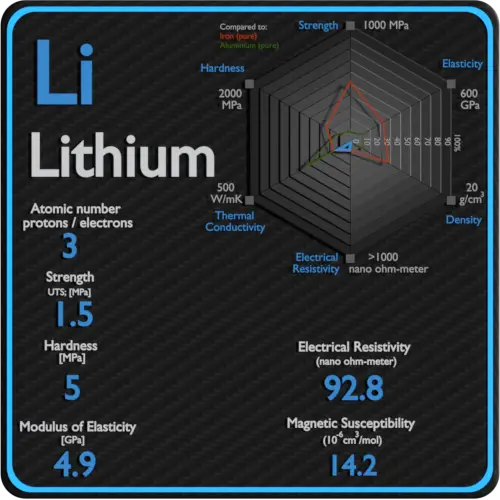About Lithium
It is a soft, silvery-white alkali metal. Under standard conditions, it is the lightest metal and the lightest solid element. Like all alkali metals, lithium is highly reactive and flammable, and is stored in mineral oil.
Summary
| Element | Lithium |
| Atomic number | 3 |
| Element category | Alkali Metal |
| Phase at STP | Solid |
| Density | 0.535 g/cm3 |
| Ultimate Tensile Strength | 1.5 MPa |
| Yield Strength | N/A |
| Young’s Modulus of Elasticity | 4.9 GPa |
| Mohs Scale | 0.6 |
| Brinell Hardness | 5 MPa |
| Vickers Hardness | N/A |
| Melting Point | 180.5 °C |
| Boiling Point | 1342 °C |
| Thermal Conductivity | 85 W/mK |
| Thermal Expansion Coefficient | 46 µm/mK |
| Specific Heat | 3.6 J/g K |
| Heat of Fusion | 3 kJ/mol |
| Heat of Vaporization | 145.92 kJ/mol |
| Electrical resistivity [nanoOhm meter] | 92.8 |
| Magnetic Susceptibility | +14.2e-6 cm^3/mol |
Applications of Lithium
Lithium has many applications, from lubricating grease, alloying additions in particular for aluminium and magnesium alloys, to glazes for ceramics, and finally, lithium batteries. In particular, lithium is and will continue to play an increasingly important role in the battery-powered clean air future. Lithium batteries are widely used in portable consumer electronic devices, and in electric vehicles ranging from full sized vehicles to radio controlled toys. The term “lithium battery” refers to a family of different lithium-metal chemistries, comprising many types of cathodes and electrolytes but all with metallic lithium as the anode.
Production and Price of Lithium
Raw materials prices change daily. They are primarily driven by supply, demand and energy prices. In 2019, prices of pure Lithium were at around 270 $/kg.
Lithium production has greatly increased since the end of World War II. Lithium is present in a number of different minerals, but for those who deal with its commercial extraction, there are really only a few that are of interest. The metal is separated from other elements in igneous minerals. The metal is produced through electrolysis from a mixture of fused 55% lithium chloride and 45% potassium chloride at about 450 °C. As of 2015, most of the world’s lithium production is in South America, where lithium-containing brine is extracted from underground pools and concentrated by solar evaporation. The standard extraction technique is to evaporate water from brine. Depending on the climate and weather in the region of the brine deposit, lithium concentration can take a few months to a year. Typically, lithium concentrations range between 1 and 2%.
Source: www.luciteria.com
Mechanical Properties of Lithium
Strength of Lithium
In mechanics of materials, the strength of a material is its ability to withstand an applied load without failure or plastic deformation. Strength of materials basically considers the relationship between the external loads applied to a material and the resulting deformation or change in material dimensions. In designing structures and machines, it is important to consider these factors, in order that the material selected will have adequate strength to resist applied loads or forces and retain its original shape. Strength of a material is its ability to withstand this applied load without failure or plastic deformation.
For tensile stress, the capacity of a material or structure to withstand loads tending to elongate is known as ultimate tensile strength (UTS). Yield strength or yield stress is the material property defined as the stress at which a material begins to deform plastically whereas yield point is the point where nonlinear (elastic + plastic) deformation begins.
See also: Strength of Materials
Ultimate Tensile Strength of Lithium
Ultimate tensile strength of Lithium is 1.5 MPa.
Yield Strength of Lithium
Yield strength of Lithium is N/A.
Modulus of Elasticity of Lithium
The Young’s modulus of elasticity of Lithium is 4.9 GPa.
Hardness of Lithium
In materials science, hardness is the ability to withstand surface indentation (localized plastic deformation) and scratching. Brinell hardness test is one of indentation hardness tests, that has been developed for hardness testing. In Brinell tests, a hard, spherical indenter is forced under a specific load into the surface of the metal to be tested.
Brinell hardness of Lithium is approximately 5 MPa.
The Vickers hardness test method was developed by Robert L. Smith and George E. Sandland at Vickers Ltd as an alternative to the Brinell method to measure the hardness of materials. The Vickers hardness test method can be also used as a microhardness test method, which is mostly used for small parts, thin sections, or case depth work.
Vickers hardness of Lithium is approximately N/A.
Scratch hardness is the measure of how resistant a sample is to permanent plastic deformation due to friction from a sharp object. The most common scale for this qualitative test is Mohs scale, which is used in mineralogy. The Mohs scale of mineral hardness is based on the ability of one natural sample of mineral to scratch another mineral visibly.
Lithium is has a hardness of approximately 0.6.
See also: Hardness of Materials
Lithium – Crystal Structure
A possible crystal structure of Lithium is body-centered cubic structure.
In metals, and in many other solids, the atoms are arranged in regular arrays called crystals. A crystal lattice is a repeating pattern of mathematical points that extends throughout space. The forces of chemical bonding causes this repetition. It is this repeated pattern which control properties like strength, ductility, density, conductivity (property of conducting or transmitting heat, electricity, etc.), and shape. There are 14 general types of such patterns known as Bravais lattices.
See also: Crystal Structure of Materials
Crystal Structure of Lithium

Thermal Properties of Lithium
Lithium – Melting Point and Boiling Point
Melting point of Lithium is 180.5°C.
Boiling point of Lithium is 1342°C.
Note that, these points are associated with the standard atmospheric pressure.
Lithium – Thermal Conductivity
Thermal conductivity of Lithium is 85 W/(m·K).
The heat transfer characteristics of a solid material are measured by a property called the thermal conductivity, k (or λ), measured in W/m.K. It is a measure of a substance’s ability to transfer heat through a material by conduction. Note that Fourier’s law applies for all matter, regardless of its state (solid, liquid, or gas), therefore, it is also defined for liquids and gases.
Coefficient of Thermal Expansion of Lithium
Linear thermal expansion coefficient of Lithium is 46 µm/(m·K)
Thermal expansion is generally the tendency of matter to change its dimensions in response to a change in temperature. It is usually expressed as a fractional change in length or volume per unit temperature change.
Lithium – Specific Heat, Latent Heat of Fusion, Latent Heat of Vaporization
Specific heat of Lithium is 3.6 J/g K.
Heat capacity is an extensive property of matter, meaning it is proportional to the size of the system. Heat capacity C has the unit of energy per degree or energy per kelvin. When expressing the same phenomenon as an intensive property, the heat capacity is divided by the amount of substance, mass, or volume, thus the quantity is independent of the size or extent of the sample.
Latent Heat of Fusion of Lithium is 3 kJ/mol.
Latent Heat of Vaporization of Lithium is 145.92 kJ/mol.
Latent heat is the amount of heat added to or removed from a substance to produce a change in phase. This energy breaks down the intermolecular attractive forces, and also must provide the energy necessary to expand the gas (the pΔV work). When latent heat is added, no temperature change occurs. The enthalpy of vaporization is a function of the pressure at which that transformation takes place.
Lithium – Electrical Resistivity – Magnetic Susceptibility
Electrical property refers to the response of a material to an applied electric field. One of the principal characteristics of materials is their ability (or lack of ability) to conduct electrical current. Indeed, materials are classified by this property, that is, they are divided into conductors, semiconductors, and nonconductors.
See also: Electrical Properties
Magnetic property refers to the response of a material to an applied magnetic field. The macroscopic magnetic properties of a material are a consequence of interactions between an external magnetic field and the magnetic dipole moments of the constituent atoms. Different materials react to the application of magnetic field differently.
See also: Magnetic Properties
Electrical Resistivity of Lithium
Electrical resistivity of Lithium is 92.8 nΩ⋅m.
Electrical conductivity and its converse, electrical resistivity, is a fundamental property of a material that quantifies how Lithium conducts the flow of electric current. Electrical conductivity or specific conductance is the reciprocal of electrical resistivity.
Magnetic Susceptibility of Lithium
Magnetic susceptibility of Lithium is +14.2e-6 cm^3/mol.
In electromagnetism, magnetic susceptibility is the measure of the magnetization of a substance. Magnetic susceptibility is a dimensionless proportionality factor that indicates the degree of magnetization of Lithium in response to an applied magnetic field.


























